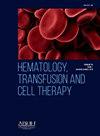ST2 and Reg3α: Can they predict aGvHD, steroid refractoriness and transplant-related mortality in pediatric patients after HSCT?
IF 1.8
Q3 HEMATOLOGY
引用次数: 0
Abstract
Background/aim
There are several complications of hematopoietic stem cell transplantation. Without any doubt, most important of these is aGvHD that increases transplant-related mortality. The aim of this study is to investigate whether ST-2 and Reg3α levels measured at an early stage in pediatric patients undergoing allogeneic hematopoietic stem cell transplantation can be individual biomarkers identifying future GvHD and predicting treatment response.
Materials and methods
From January 2019 to January 2021, 27 patients undergoing hematopoietic stem cell transplantation for primary immunodeficiency or hematopoietic diseases formed the study group. During their follow-up, the patients were classified into two groups as those developing and those not developing aGvHD. Nineteen healthy volunteers from a similar age group who needed their blood samples drawn for other reasons and who did not have any history of chronic disease, infection or medication use formed the control group. Blood samples of patients scheduled to have allogeneic HSCT were obtained before the administration of the preparative regimen, on Day +7 post-transplant and on the day of diagnosis if they developed aGvHD. Serum samples were stored at -20ºC until the day of processing. ST2 and Reg3α levels were measured using the ELISA method.
Results
For patients who developed aGvHD (n = 13), ST2 levels obtained before the transplantation, on Day +7 post-transplant and on the day of aGvHD diagnosis (in patients developing GvHD) were significantly higher compared to the healthy Control Group (p-value <0.05). As regards to the samples obtained on the same days, ST2 levels did not differ significantly among patients who developed and those who did not develop GvHD (n = 14; p-value >0.05). ST2 levels of samples obtained on the days that acute skin and gastrointestinal tract GvHD developed did not differ significantly between these two groups (p-value >0.05). Reg3α levels of the pre-transplant samples, on Day +7 after the transplantation and on the day of aGvHD diagnosis did not show any difference between any of the groups (p-value >0.05). As only two patients died after transplantation, thus correlation of ST2 and Reg3α levels with transplant-related mortality could not be proven.
Conclusion
The results of this study suggest that ST2 and Reg3α levels are neither diagnostic nor prognostic or predictive biomarkers of aGvHD, steroid resistance or transplant-related mortality in pediatric patients. This study can be regarded as a pilot study because of the small patient population; more research involving a larger patient population is required.
ST2 和 Reg3α:它们能否预测造血干细胞移植后儿科患者的严重营养不良、类固醇耐受性和移植相关死亡率?
本文章由计算机程序翻译,如有差异,请以英文原文为准。
求助全文
约1分钟内获得全文
求助全文
来源期刊

Hematology, Transfusion and Cell Therapy
Multiple-
CiteScore
2.40
自引率
4.80%
发文量
1419
审稿时长
30 weeks
 求助内容:
求助内容: 应助结果提醒方式:
应助结果提醒方式:


